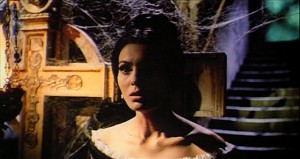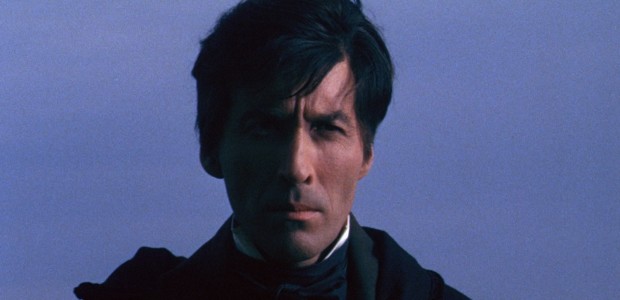Unearthing the Gothic is a monthly column where we explore the vast and exciting world of gothic horror media as a way to exhume it from the margins of conversation and preserve its importance to the genre.
Mario Bava is known as one of the premiere purveyors of Italian gothic horror cinema as well as being one of the foremost fathers of the giallo subgenre. When he wasn’t crafting horrific and interesting death scenes and twisty plots, he was making lush and captivating gothic films that are so beautiful that it makes the heart ache. Perhaps one of his most misunderstood gothic efforts is THE WHIP AND THE BODY, a story that blends the sensual and the macabre as well as pleasure and pain. The film has been often reduced to beautiful trash — as if there is something wrong with a film being beautiful trash in the first place. However, the film has some deep meditation on sexual repression and desire while also being the dishy and melodramatic gothic horror that we all know and love — and yes, it is also extremely visually beautiful.

THE WHIP AND THE BODY begins with prodigal son Kurt Menliff (Christopher Lee) returning to his family estate to reclaim his title. His father, Count Menliff (Gustavo de Nardo), cast Kurt out and disinherited him due to a tryst with the family servant’s daughter that led to the woman’s suicide. Kurt was set to marry Nevenka (Dalia Lavi) before his exile. Nevenka has since married Christian (Tony Kendall), Kurt’s younger brother. Of course, in true gothic fashion, the situation devolves upon Kurt’s arrival when Nevenka’s passions for him resurface. Events further degrade when Kurt is mysteriously murdered and Nevenka is haunted by his ghost and her own desires.
This movie doesn’t shy away from sexuality. The gothic is known for sensuality and romance. It’s a naturally amorous genre, or — if you want to be uncouth — it’s downright horny. Christopher Lee’s Kurt Menliff is basically dripping in sex appeal as a broody and menacing gothic villain. He’s the sort of character that falls directly in the Byronic hero category right alongside the likes of Heathcliff from Emily Bronte’s Wuthering Heights. Kurt isn’t the sort of man that a woman would want to indulge in real life, but he’s the sort of person that strikes the heart of the audience’s darkest fantasies. He’s appealing because he represents humanity’s darkness. He’s certainly captured Nevenka’s heart and soul and her body as well. Nevenka’s longing for Kurt and their shared sadomaschistic sexual proclivities is palpable. Christian is the safe choice, but their relationship is largely sexless. Christian doesn’t even share a bed with Nevenka, and he is far more sexually and romantically interested in his cousin Katia (Evelyn Stewart credited as Ida Galli). This lack of passion naturally drives Nevenka back into Kurt’s arms, resuming a volatile affair that slakes his lust for sadism and her desire for masochism. In the midst of it all, Nevenka realizes she still loves him despite his domineering nature and her marriage to his brother. It’s a tangled sexual web.

Much of Nevenka’s inner turmoil stems from repression. Her desires are not met in her marriage, and she tries vehemently to make herself believe she hates Kurt and that she loves Christian. Kurt is most certainly not an ideal mate. He’s cruel and vicious and more than a little lascivious, but he gives Nevenka the freedom to search her deeper impulses. Christian — again being the safer choice — is boring and often alienating. When Nevenka comes to him and tells him Kurt is haunting her, he brushes her off. Nevenka is more of a pretty fixture in the Menliff household than she is a true partner to Christian. It’s a hollow existence. Being the delicate and perfect wife of the heir to the countship is expected of her. There’s little intimacy between the two, whether it be sexual or emotional — whereas Kurt gives Nevenka the intensity she seeks. Her torrid scenes with Kurt are burbling with want and emotion while her scenes with Christian are tepid. Who wants a love that is barely lukewarm? Christian’s milquetoast sensibilities makes Kurt look beyond palatable in comparison. Bava positions the brothers as romantic foils and makes the audience empathize with her conflict because naturally, the viewer is conflicted as well.
The film’s luxuriant beauty makes the story all the more alluring. Bava juxtaposes scenes of sexually charged terror with appealing visuals. It’s a sort of technicolor madness that draws in the viewer. It’s the film equivalent of the gothic novel. It’s elaborate prose translated into a visual medium. The beauty of the gothic genre is captured clearly with Bava’s keen penchant for creating an arresting feast for the senses. No wonder this film’s visuals inspired Guillermo del Toro when making his own gothic tour de force CRIMSON PEAK. The sets bring with a macabre sort of opulence and come together in full with a rich color story and costuming. The gothic might be grotesque but it will often always be one of the most prepossessing experiences.
Like all media, THE WHIP AND THE BODY isn’t for everyone, but it most certainly is a love letter to all things gothic horror. Bava was a master at crafting horror that was made for those who adore it, and this film is no different. His gothic flare is unparalleled and significant and worth the exploration that is readily given to his giallo entries in the Italian horror canon. If the thought of THE WHIP AND THE BODYdoesn’t leave you enthralled, you might want to check out some of Bava’s other gothic offerings including BLACK SUNDAY; BLACK SABBATH; LISA AND THE DEVIL; and KILL, BABY, KILL.
Tags: Giallo, Gothic Horror, Italian Horror Films, mario bava, The Whip and the Body, Unearthing the Gothic


No Comments